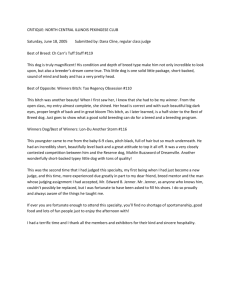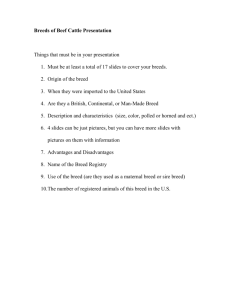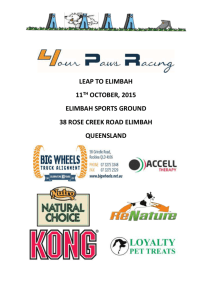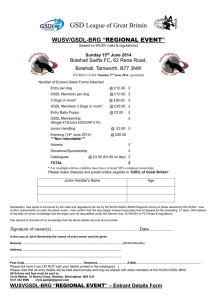12_TypeInTheBreed - Border Collie Society of America
advertisement
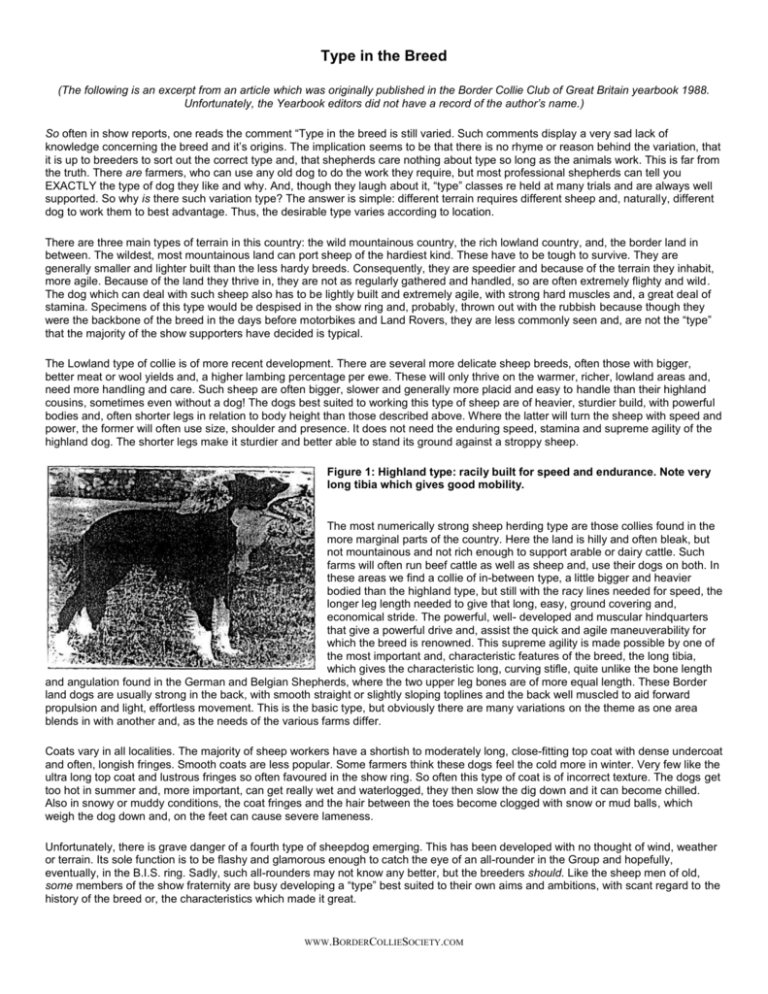
Type in the Breed (The following is an excerpt from an article which was originally published in the Border Collie Club of Great Britain yearbook 1988. Unfortunately, the Yearbook editors did not have a record of the author’s name.) So often in show reports, one reads the comment “Type in the breed is still varied. Such comments display a very sad lack of knowledge concerning the breed and it’s origins. The implication seems to be that there is no rhyme or reason behind the variation, that it is up to breeders to sort out the correct type and, that shepherds care nothing about type so long as the animals work. This is far from the truth. There are farmers, who can use any old dog to do the work they require, but most professional shepherds can tell you EXACTLY the type of dog they like and why. And, though they laugh about it, “type” classes re held at many trials and are always well supported. So why is there such variation type? The answer is simple: different terrain requires different sheep and, naturally, different dog to work them to best advantage. Thus, the desirable type varies according to location. There are three main types of terrain in this country: the wild mountainous country, the rich lowland country, and, the border land in between. The wildest, most mountainous land can port sheep of the hardiest kind. These have to be tough to survive. They are generally smaller and lighter built than the less hardy breeds. Consequently, they are speedier and because of the terrain they inhabit, more agile. Because of the land they thrive in, they are not as regularly gathered and handled, so are often extremely flighty and wild. The dog which can deal with such sheep also has to be lightly built and extremely agile, with strong hard muscles and, a great deal of stamina. Specimens of this type would be despised in the show ring and, probably, thrown out with the rubbish because though they were the backbone of the breed in the days before motorbikes and Land Rovers, they are less commonly seen and, are not the “type” that the majority of the show supporters have decided is typical. The Lowland type of collie is of more recent development. There are several more delicate sheep breeds, often those with bigger, better meat or wool yields and, a higher lambing percentage per ewe. These will only thrive on the warmer, richer, lowland areas and, need more handling and care. Such sheep are often bigger, slower and generally more placid and easy to handle than their highland cousins, sometimes even without a dog! The dogs best suited to working this type of sheep are of heavier, sturdier build, with powerful bodies and, often shorter legs in relation to body height than those described above. Where the latter will turn the sheep with speed and power, the former will often use size, shoulder and presence. It does not need the enduring speed, stamina and supreme agility of the highland dog. The shorter legs make it sturdier and better able to stand its ground against a stroppy sheep. Figure 1: Highland type: racily built for speed and endurance. Note very long tibia which gives good mobility. The most numerically strong sheep herding type are those collies found in the more marginal parts of the country. Here the land is hilly and often bleak, but not mountainous and not rich enough to support arable or dairy cattle. Such farms will often run beef cattle as well as sheep and, use their dogs on both. In these areas we find a collie of in-between type, a little bigger and heavier bodied than the highland type, but still with the racy lines needed for speed, the longer leg length needed to give that long, easy, ground covering and, economical stride. The powerful, well- developed and muscular hindquarters that give a powerful drive and, assist the quick and agile maneuverability for which the breed is renowned. This supreme agility is made possible by one of the most important and, characteristic features of the breed, the long tibia, which gives the characteristic long, curving stifle, quite unlike the bone length and angulation found in the German and Belgian Shepherds, where the two upper leg bones are of more equal length. These Border land dogs are usually strong in the back, with smooth straight or slightly sloping toplines and the back well muscled to aid forward propulsion and light, effortless movement. This is the basic type, but obviously there are many variations on the theme as one area blends in with another and, as the needs of the various farms differ. Coats vary in all localities. The majority of sheep workers have a shortish to moderately long, close-fitting top coat with dense undercoat and often, longish fringes. Smooth coats are less popular. Some farmers think these dogs feel the cold more in winter. Very few like the ultra long top coat and lustrous fringes so often favoured in the show ring. So often this type of coat is of incorrect texture. The dogs get too hot in summer and, more important, can get really wet and waterlogged, they then slow the dig down and it can become chilled. Also in snowy or muddy conditions, the coat fringes and the hair between the toes become clogged with snow or mud balls, which weigh the dog down and, on the feet can cause severe lameness. Unfortunately, there is grave danger of a fourth type of sheepdog emerging. This has been developed with no thought of wind, weather or terrain. Its sole function is to be flashy and glamorous enough to catch the eye of an all-rounder in the Group and hopefully, eventually, in the B.I.S. ring. Sadly, such all-rounders may not know any better, but the breeders should. Like the sheep men of old, some members of the show fraternity are busy developing a “type” best suited to their own aims and ambitions, with scant regard to the history of the breed or, the characteristics which made it great. WWW.BORDERCOLLIESOCIETY.COM Figure 2: Lowland dog: with legs too short in proportion to body length, and body too heavy for prolonged speed. Theoretically, all working breed standards are supposed to be based upon those characteristics which make a breed most suitable for the type of work for which it was originally developed. Unfortunately, most breed Standards are so worded that they can be adapted to suit any judge’s interpretation and ideals. This leaves plenty of room for fads, fancies and fashions, all of which can he harmful to the breed. You don’t agree? Think how many judges can only “see” a Border Collie that has “correct” markings. It is well known that an all black animal, a black faced or, horror of horrors a half-white-faced animal, would seldom, if ever, win the show ring, no matter how good the “type”, conformation and, movement. A very sorry state of affairs when the standard makes no mention or definition of correct markings saying simply that “white should, never predominate.” Markings should be the icing on the cake, not, as they seem to be now, both cake AND icing! There are similar fads concerning ear carriage. Many judges seem to prefer really heavy, soft ears to prick ears, yet the latter are clearly far better suited to a breed where acute hearing is an essential prerequisite for work. Again, such prejudices are in direct contradiction to the standard, which states that ears should he ‘carried erect or semi-erect” As to prejudices regarding colour and coat length, many so called judges make a nonsense of the standard and cannot “see any colour other than Black and White or, perhaps, B.W.T. or any coat length other than long. Is there ever any likelihood of a smooth coated champion? As things are at present, it would be most unlikely. Isn’t it about time that those who wish to set themselves up as judges a) read the standard properly and b) learn to recognise the anatomical and mechanical “bits” that really matter. Would you accept someone as a good judge of a car if they selected one that, though beautifully painted and polished, turned out on closer inspection, to have faulty bodywork and, no engine! The Border land type of collie is probably now the most typical sheep worker and, surely, the type we should be aiming for in the breed. At one time, the breed seemed to be swinging rapidly towards the lowland type collie, with front legs of shorter length than the length from shoulder to elbow, the too heavy body type and, the heavy coat and fringing so unsuited to most working conditions. There are still several of this type around, but thankfully there are more of the more correct type which dog would be capable of doing a day’s work. Figure 3: Borderland type: with longer front leg in proportion to body depth. Still has long tibia for agility, turning speed and maneuverability. Body correct weight for build and good working ability. There are plenty of good books which explain clearly and, in an interesting manner, the relationship between structure and function. Probably one of the finest is “Dog Locomotion & Gait Analysis” by Curtis M. Brown, and McDowell Lyon’s “The Dog In Action” (both a bit pricey, but well worth the money). The alternative is to breed only a “show” type where markings, ears, colour, and coat and, glamour are the most vital features. If that is what breeders want, why not be honest, change the name to “Show Collie” and forget the “Border”. Are we going to combine these features with short legs, heavy bodies and, straight back legs? If so perhaps the term “Lowland Collie” or the “Lowland Show Collie” would be more appropriate. If we ARE going to change the name, perhaps we should alter the temperament as well. The Border land collie is alert, active, intelligent and, interested in everything that goes on. Not perhaps the easiest kind to handle in the show ring. Never the type that will stand placed and unmoving with gaze fixed unfalteringly on a lump of liver. Beware those who would change and alter the breed to their own ends. Consider the Alsatian/German Shepherds who have trodden this pathway and, the splits and problems this has caused in that breed, none of it in the breed’s interest. Look at the types in that breed, one big, heavy and plodding with short legs and quiet personality. You might not like the other type (or perhaps its owner/handlers), but at least they have returned nearer to the true working type and temperament. If we are going to stick with the “Border Collie”, let’s concentrate on breeding the Border land “type” of collie. It’s an excellent and versatile type and, so worthwhile breeding dogs that could WORK this kind of terrain. But don’t forget, if you are breeding the Border Collie, then conformation, movement and lively temperament are first and foremost. When that is perfected, then we can worry about markings etc; but let’s get our priorities straight, the Border Collie must be a Border land collie and, one that the sheep men would happily recognise and welcome, for they are no fools and, have been at it for longer than we have. As for variation in type, if the Border type is the right type, then everything else isn’t simply a different type, it is WRONG. You cannot judge, breed, or “develop” the “Border” Collie without making the effort to understand it’s heritage and, the reasons why it is built the way it is. They go hand in hand, or not at all. Those who think that they should concentrate solely upon the show collie in isolation from anything else should call the breed by its correct name the “Show Collie”, for that is all it will ever be and, in another 100 years, people will once again be seeking K.C. recognition for the true Border collie. WWW.BORDERCOLLIESOCIETY.COM


